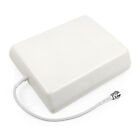Like many folks who live in the middle of nowhere, I was stuck with limited options for broadband Internet access. In this case, “limited” meant none at all based on the FTC’s definition of 25Mbps.
I could go with satellite access, which was expensive, exceptionally buggy, and has customer service ratings that rival Comcast in a race to the bottom. The other option is CenturyLink DSL. I went with that one. It was far cheaper than satellite but I was limited to a maximum of 1.5Mbps. I’ve never seen 1.5, even though I’ve tuned my modem so it can run at 1.7Mbps. Normal service runs around 0.8Mbps, which is roughly a bit over dial-up speeds. A quarter of the time it drops to 0.12Mbps, or 120Kbps, because CenturyLink refuses to upgrade the ancient equipment on my local stinger.
Now, 0.8Mbps is good enough for the lowest resolution streaming from Netflix and Amazon Prime, with an occasional burp as it re-buffers…usually at an important point of the show I’m watching.
The problem for me is that I need to stream better resolution (for my sanity) and, as an author, I need to do some online work like setting up and maintaining websites, transferring documents and images to publishers, and even getting on video podcasts.
That last item is the straw that made me figure out how to get better service.
This is going to be a blog series as I walk through and document setting up equipment.
In the past I used Verizon Home Wireless, which allowed 22Mbps service. If you do some digging around you’ll find some horror stories. I also suffered through using Verizon, including one month where my bill had an extra $180 tacked on even though I was traveling. Apparently I used up my data allotment without actually using the Internet, plus my modem was unplugged because I didn’t want it to get damaged by lightning when I was traveling. They couldn’t explain how this was possible but they threatened me until I paid it and cancelled service, which they charged me another $250 in fees.
TL;DR for Verizon: Don’t use them unless you hate having money in your bank account.
![]() Eventually I discovered OTR Mobile, which gives you unlimited, unthrottled 4G LTE data for $60/month over AT&T’s network. They had a lot of good reviews. I went ahead and ordered a refurbished wireless hotspot for $296 (which comes with the first month of service), including $16 for two-day FedEx shipping.
Eventually I discovered OTR Mobile, which gives you unlimited, unthrottled 4G LTE data for $60/month over AT&T’s network. They had a lot of good reviews. I went ahead and ordered a refurbished wireless hotspot for $296 (which comes with the first month of service), including $16 for two-day FedEx shipping.
They noted that the hotspot I ordered was on backorder until May 29, 2019, so I was fine with that. It didn’t ship until today, June 4th, so I got on the chat on their website and they reimbursed my $16 shipping charges. OK, good customer service so far.
 I only get one to two bars of service on my cellphone out here in the boonies, so I also researched and ordered a SureCall wireless booster system. It acts like a relay tower and should give me five bars of service plus a 70+db boost in signal with the built in amplifier. Toss in an external Yagi antenna (very focused) and I should get an exceptional connection to the nearest tower, which is over eight miles away.
I only get one to two bars of service on my cellphone out here in the boonies, so I also researched and ordered a SureCall wireless booster system. It acts like a relay tower and should give me five bars of service plus a 70+db boost in signal with the built in amplifier. Toss in an external Yagi antenna (very focused) and I should get an exceptional connection to the nearest tower, which is over eight miles away.
 I picked up the SureCall on eBay (here’s the link, and the seller was excellent). I also got another flat-panel antenna for my house to prevent oscillation between the input and output of the amplifier (link on eBay). Total investment is $413.25 for the cell booster portion of this project.
I picked up the SureCall on eBay (here’s the link, and the seller was excellent). I also got another flat-panel antenna for my house to prevent oscillation between the input and output of the amplifier (link on eBay). Total investment is $413.25 for the cell booster portion of this project.
Yes, it’s expensive and I had to save up for the project but reliable, reasonably fast Internet service is important for me. I put up with ramen and hot dogs, and can now make them rather tasty if I do say so myself.
My next step is to put up the SureCall cell booster outdoor antenna, so that will be the next step of the project.